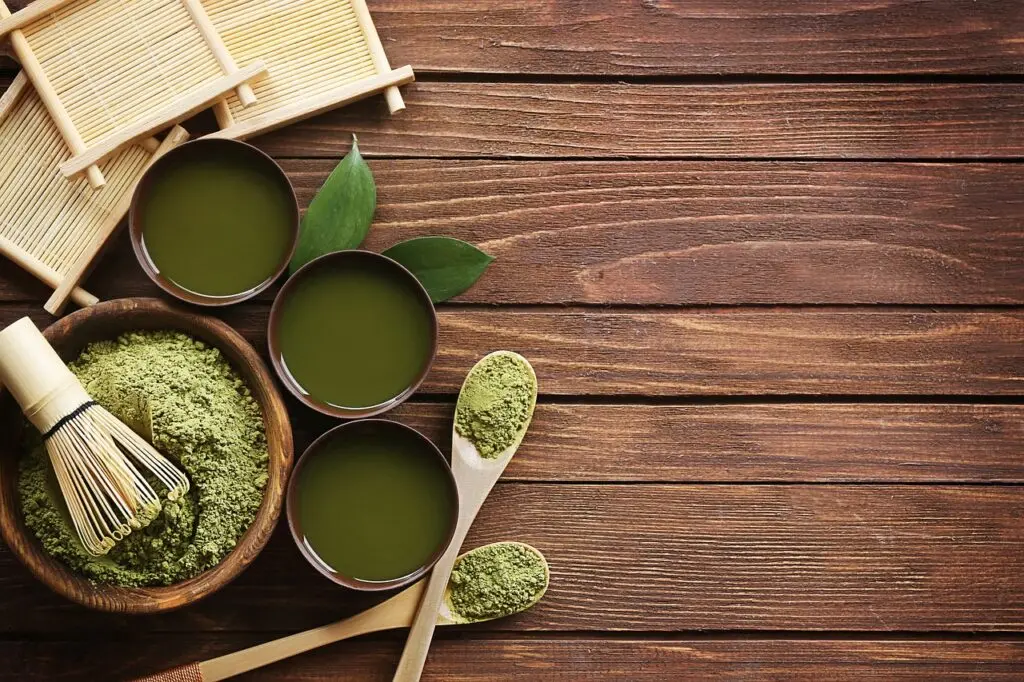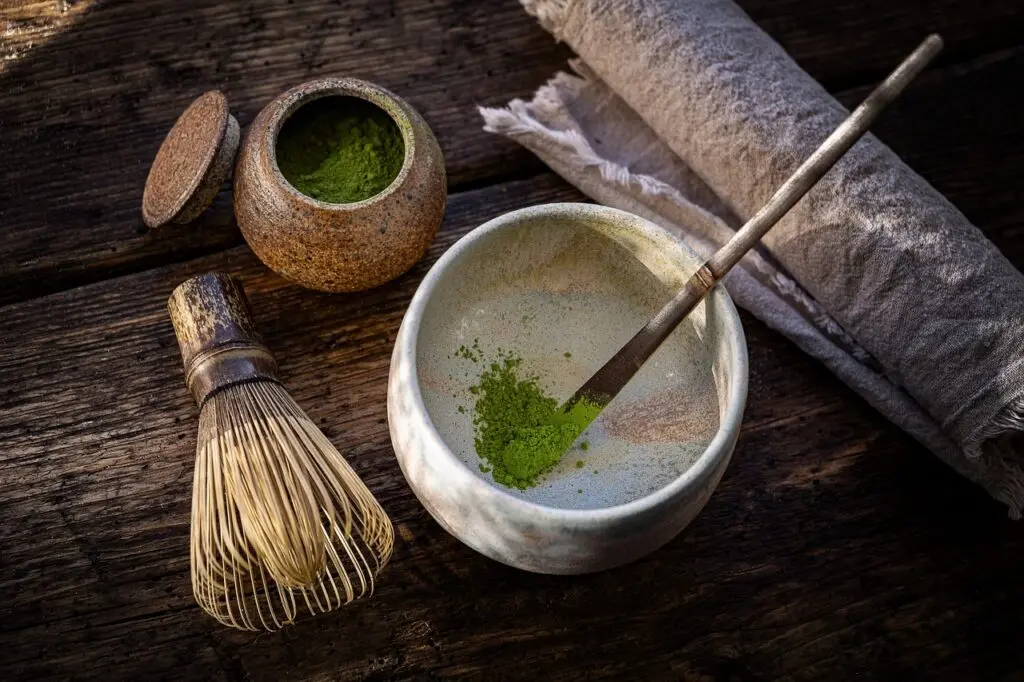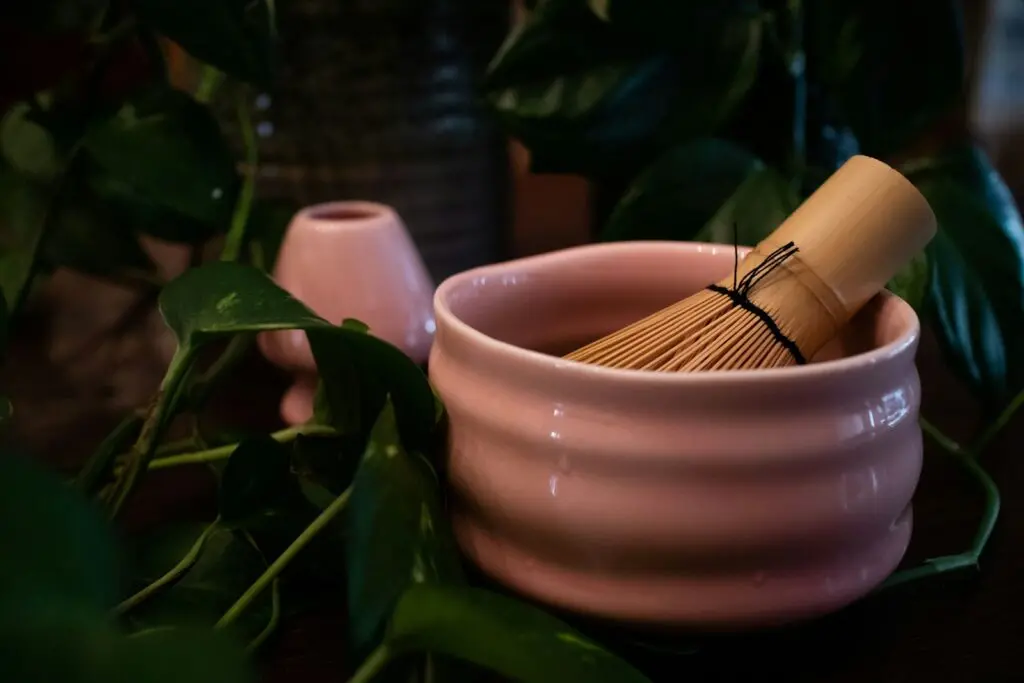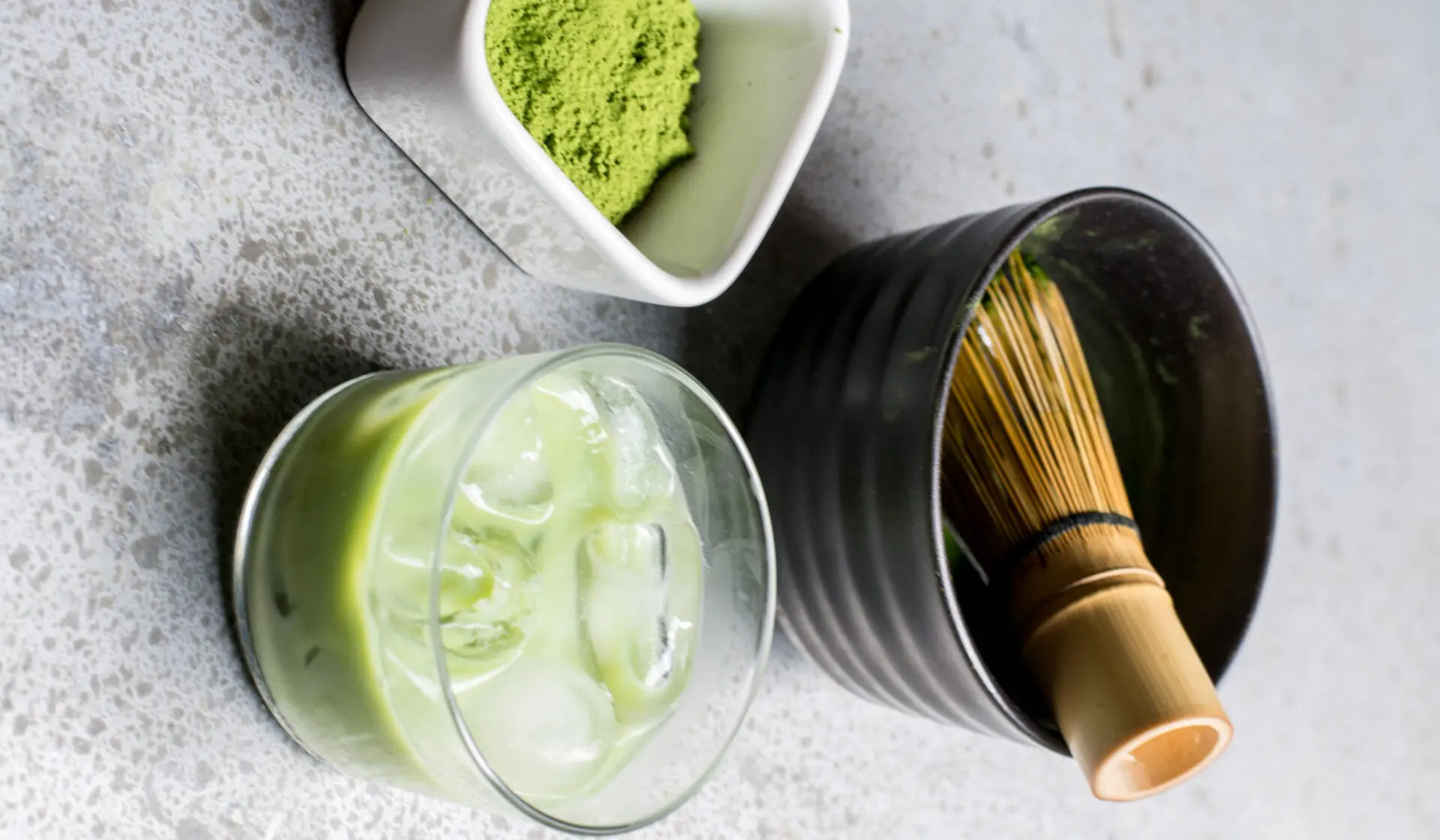Introduction to Matcha: A Brief Overview
Matcha, a vibrant green powdered tea, has enchanted tea lovers across the globe with its unique flavor profile and numerous health benefits. Originating from Japan, this finely ground green tea is made from shade-grown tea leaves, specifically the Camellia sinensis plant. Unlike traditional green tea, where leaves are steeped in water and then discarded, matcha invites the drinker to consume the whole leaf, leading to a more concentrated infusion of flavour and nutrients.
Historically, matcha has deep roots in Japanese culture, dating back to the 12th century when it was introduced by Zen Buddhist monks. It quickly gained popularity, connecting with spiritual practices and the Japanese tea ceremony, known as Chanoyu. This ceremonial preparation of matcha is an art form, emphasizing mindfulness and the aesthetic appreciation of tea.
The production of matcha involves meticulous processes: after the tea leaves are grown in the shade to enhance their chlorophyll content, they are hand-picked, steamed to prevent oxidation, and then slowly dried. The leaves are ground into a fine powder using traditional stone mills. This careful craftsmanship not only preserves the high levels of antioxidants typically associated with green tea but also enhances the umami flavour that distinguishes matcha from its counterparts.
In recent years, matcha has transcended its traditional roots, becoming a popular ingredient in smoothies, lattes, desserts, and even savoury dishes. Its vibrant green color and unique flavour have made it a sought-after addition to contemporary culinary creations. As interest in health and wellness flourishes, matcha continues to be celebrated for its potential health benefits, including boosting metabolism, providing sustained energy, and offering a wealth of antioxidants, making it a perfect choice for those seeking a delicious yet nourishing beverage.
With its rich history, cultural significance, and growing global popularity, matcha is not just a drink; it embodies a lifestyle and a philosophy of well-being worth exploring further.

The Matcha Production Process
The journey of matcha from leaf to cup is a meticulous and intricate process that involves several detailed steps, each contributing to its unique flavour, aroma, and health benefits. Understanding the production process not only deepens appreciation for this revered beverage but also highlights the skill and dedication involved in crafting high-quality matcha.
1. Cultivation of Tea Plants
The production of matcha begins in the lush tea fields of Japan, where the tea plants, specifically the variety known as Camellia sinensis, are cultivated. About three to four weeks before harvest, the tea plants are shaded with canvas or straw. This shading process is crucial as it increases chlorophyll production, enhances the amino acid content, and gives the leaves their vibrant green hue. Shading also reduces the bitterness of the leaves, ultimately contributing to matcha’s signature umami flavour.
2. Harvesting the Leaves
Once the tea leaves reach optimal maturity, specially trained workers hand-pick the youngest and freshest leaves, usually targeting the top two or three leaves and the bud. This selective harvesting is essential for obtaining the highest quality matcha, as these tender leaves possess the most concentrated flavour and nutrients. The skill of the harvesters plays a significant role in ensuring that only the best leaves are chosen for processing.
3. Steaming and Drying
After harvesting, the leaves are quickly steamed to halt oxidation, preserving their vibrant green colour and fresh flavour. This steaming process typically lasts about 15 to 20 seconds. Following steaming, the leaves are carefully dried to remove excess moisture. This step is vital for ensuring that the leaves are well-preserved and can be ground into matcha powder without losing their quality.
4. Destemming and Grinding
Once dried, the leaves—now referred to as tencha — undergo a destemming process where the stems and veins are removed. This step ensures that only the pure leaf material is ground into matcha. The final grinding is done with traditional stone mills, which grind the leaves slowly and gently to a fine powder. This method not only prevents heat from degrading the delicate flavours and nutrients but also allows for the production of a very fine, silky matcha that is essential for a smooth drinking experience.
5. Packaging and Storage
Once ground, matcha is packaged into airtight containers to protect it from light, moisture, and air, which can all degrade its quality. Proper storage is vital for maintaining the freshness and potency of matcha, as exposure to the elements can diminish its flavour and health benefits. High-quality matcha is often packaged in small quantities to ensure that consumers can enjoy it at its best.

Different Types of Matcha
When it comes to matcha, not all powders are created equal. The quality, flavour, and purpose of matcha can vary significantly based on several factors, including the cultivation method, processing technique, and intended use. Understanding the different types of matcha can enhance your appreciation for this unique tea and guide you in selecting the best one for your needs.
1. Ceremonial Grade Matcha
Ceremonial grade matcha is the highest quality matcha available and is typically reserved for traditional tea ceremonies. This type of matcha is made from the youngest, most tender leaves, resulting in a vibrant green colour and a delicate, sweet flavour profile. It is finely ground and has a smooth texture, making it ideal for whisking into hot water and drinking plain. Due to its high quality, ceremonial-grade matcha is often more expensive than other types, but it provides an unparalleled experience for tea novices and connoisseurs alike.
2. Culinary Grade Matcha
Culinary-grade matcha is slightly less refined than ceremonial grade and is specifically designed for cooking and baking. This type of matcha is made from mature leaves, which gives it a more robust, sometimes slightly bitter flavour. Culinary-grade matcha is perfect for incorporating into recipes such as matcha lattes, smoothies, desserts, and savoury dishes. While it may not offer the same delicate flavour as ceremonial matcha, it still retains many of the health benefits associated with matcha tea.
3. Premium Grade Matcha
Premium grade matcha falls between ceremonial and culinary grades. This type of matcha is of high quality and is suitable for both drinking and culinary uses. It maintains a vibrant green colour and has a balanced flavour profile that allows it to shine in a variety of applications. Those who seek a good balance between quality and affordability often choose premium-grade matcha for their daily consumption.
4. Ingredient-Specific Matchas
With the growing interest in matcha, many brands now offer ingredient-specific matches tailored for certain uses. For example, some matches are blended with flavoured powders like vanilla, chocolate, or spices to create unique blends for cooking or smoothies. While these flavoured options may appeal to some, purists often prefer the classic, unadulterated matcha experience.
5. Organic vs. Non-Organic Matcha
Lastly, matcha is also categorized based on its cultivation practices. Organic matcha is grown without synthetic pesticides or fertilizers, adhering to strict agricultural standards. Non-organic matcha may use conventional farming methods, including chemicals. Organic matcha is often favored for its purity and environmental considerations, though many high-quality non-organic matches can also deliver excellent flavour and health benefits.
Health Benefits of Matcha
Matcha tea is celebrated not only for its unique flavour profile and cultural significance but also for its impressive array of health benefits. Rich in antioxidants and nutrients, matcha has garnered attention from health-conscious individuals worldwide. Here are some of the key health benefits associated with consuming matcha:
1. High in Antioxidants
Matcha is packed with catechins, a type of antioxidant that helps fight free radicals in the body. One of the most potent catechins in matcha is epigallocatechin gallate (EGCG), known for its anti-inflammatory and cancer-fighting properties. The high antioxidant content supports overall health by helping to reduce oxidative stress and lower the risk of chronic diseases.
2. Boosts Metabolism and Aids in Weight Loss
Studies suggest that the combination of caffeine and catechins in matcha can enhance metabolic rate and promote fat oxidation. Drinking matcha regularly may support weight management goals and improve exercise performance. This makes it a popular choice for those seeking natural ways to incorporate a fat-burning boost into their wellness regimen.
3. Enhances Calmness and Focus
Matcha contains L-theanine, an amino acid known to induce relaxation without drowsiness. This unique combination of caffeine and L-theanine provides a more stable energy boost than coffee, allowing for improved concentration and mental clarity. Many people find that consuming matcha helps them achieve a state of calm focus, making it an ideal beverage for studying or working.
4. Supports Immune Function
The wealth of antioxidants and nutrients in matcha may also contribute to a stronger immune system. Regular consumption of matcha can help the body combat infections and illnesses due to its antiviral and antibacterial properties. Some research indicates that the polyphenols in matcha can help enhance the body’s immune response.
5. Promotes Heart Health
Regularly drinking matcha may have positive effects on heart health. Some studies have shown that matcha can help lower cholesterol levels and reduce blood pressure. Its antioxidant properties also contribute to improved overall cardiovascular health, helping to prevent conditions such as heart disease.
6. Detoxifies the Body
Matcha is grown in shade, which increases the chlorophyll content in the leaves. Chlorophyll has natural detoxifying properties and can help the body eliminate heavy metals and toxins. Incorporating matcha into your diet may thus support the liver’s detoxification processes and promote a cleaner system.
Traditional Japanese Tea Ceremony
The Traditional Japanese Tea Ceremony, known as Chanoyu or Sadō, is an intricate ritual that embodies the art of preparing and serving matcha tea. This ceremonial practice is steeped in history and philosophy, representing a harmonious blend of beauty, respect, and mindfulness that transcends mere tea drinking.
A Ritual of Aesthetics and Philosophy
The roots of the tea ceremony date back to the 12th century when Zen Buddhist monks introduced tea to Japan from China. Over the centuries, it evolved into a highly stylized ritual that emphasizes simplicity and tranquillity. The ceremony is not just about drinking tea; it is an experience that encompasses aesthetics, philosophy, and social etiquette.
Participants are invited to engage in a space defined by carefully arranged elements: the tea room (chashitsu), the utensils used, the seasonal decorations, and the overall ambience. Each setting is meticulously designed to evoke a sense of peace and appreciation for the moment, encouraging individuals to focus on the present and foster a connection with nature and each other.
The Art of Preparation
The preparation of matcha in the tea ceremony is an art form in itself. The host meticulously follows a prescribed sequence of movements known as temae. Each action—whether gathering the utensils, boiling water, or whisking the tea—requires precision and grace, reflecting a deep respect for the ingredients and the guests.
The utensils used, including the bamboo whisk (chasen), tea bowl (chawan), and tea scoop (chashaku), are selected not only for their functionality but also for their beauty. Often handcrafted, these tools embody the aesthetics of Japanese craftsmanship. The host’s skill and contemplation during the preparation process invite guests into a space of serenity.
Mindfulness and Connection
At the heart of the tea ceremony lies the philosophical principles of wa, kei, sei, and jaku—harmony, respect, purity, and tranquillity. These elements guide both the host and guests, creating an atmosphere conducive to mindfulness and reflection. The slower pace of the ceremony encourages participants to savour each moment, fostering genuine connections and deepening relationships.
As guests sip the matcha, they are invited to appreciate not just the flavour but the entire experience—the visual beauty, the fragrant aroma, and the shared silence. This communal act of tea drinking becomes a vehicle for tranquillity and connection, transcending the everyday hustle and bustle of life.

Modern Uses of Matcha
In recent years, matcha has surged in popularity far beyond traditional tea ceremonies, finding its way into various aspects of modern culinary practices and wellness routines. This vibrant green powder is not just favored for its rich flavour and vibrant colour favoured; it also boasts a myriad of health benefits attributed to its high levels of antioxidants, particularly catechins.
Culinary Innovations
Matcha has sparked a wave of creativity in kitchens worldwide. Chefs and home cooks alike are incorporating this unique ingredient into a wide range of dishes. From matcha lattes—a frothy blend of matcha powder, milk, and sweetener—to matcha-flavored desserts like cakes, cookies, and ice cream, the versatility of matcha is undeniable.
Moreover, it is used in savoury colour dishes as well. Matcha can be added to sauces, dressings, and marinades to bring an earthy yet refreshing taste. Its distinctive color also makes it an attractive ingredient for culinary presentations, enhancing the visual appeal of various dishes, from sushi rolls to pasta.
Wellness and Nutritional Benefits
The health benefits of matcha have not gone unnoticed. Packed with antioxidants, it is often lauded for boosting metabolism, providing sustained energy, and enhancing mental clarity. This has led to its inclusion in smoothies, protein powders, and energy balls targeted at health-conscious consumers looking to incorporate more superfoods into their diets.
Matcha is also popular among those practising mindfulness and wellness. Many fitness enthusiasts and yoga practitioners have embraced matcha for its natural caffeine content, providing a gentle energy lift without the jittery effects associated with coffee. The ritual of preparing and enjoying matcha can also contribute to a sense of calm and focused energy, aligning perfectly with the principles of mindfulness and overall well-being.
Beauty and Skincare
In addition to culinary and wellness applications, matcha has made a noteworthy entrance into the beauty industry. Its antioxidant properties are harnessed in various skincare products, including masks, scrubs, and creams. The anti-inflammatory and antibacterial qualities of matcha can help soothe irritated skin and reduce blemishes, making it a sought-after ingredient in natural beauty remedies.
With the rise of clean and green beauty movements, matcha-infused products have gained traction among consumers looking for effective yet natural skincare options. The application of matcha in these products not only promotes skin health but also aligns with sustainable and eco-friendly practices, appealing to the modern consumer’s values.
Tips for Brewing the Perfect Cup of Matcha
Brewing a perfect cup of matcha tea is an art that combines quality ingredients, proper techniques, and thoughtful presentation. Here are some essential tips to elevate your matcha experience:
1. Choose High-Quality Matcha
The cornerstone of a great matcha is the quality of the powder. Look for ceremonial-grade matcha, which is made from the youngest tea leaves and has a vibrant green colour, smooth texture, and sweet flavour. This type is ideal for traditional tea preparation. Culinary-grade matcha is more suited for cooking and baking. Make sure to purchase from reputable sources to guarantee freshness and authenticity.
2. Use the Right Tools
Traditionally, matcha is prepared using a few specific tools:
- Chawan (Tea Bowl): A wide bowl allows for better whisking.
- Chasen (Bamboo Whisk): This delicate tool creates a frothy texture and helps to mix the matcha evenly.
- Chashaku (Bamboo Scoop): This bamboo scoop measures out the right amount of matcha – typically one to two teaspoons per serving.
If you don’t have these traditional tools, a small whisk or frother and a regular bowl will suffice.
3. Proper Water Temperature
Temperature is crucial when brewing matcha. Boiling water can compromise the delicate flavour and nutrients of the tea. Instead, let your water cool for a few minutes after boiling. The ideal temperature for whisking matcha is between 160°F to 175°F (70°C to 80°C). Using cooler water will preserve the sweet and umami notes, making for a more enjoyable cup.
4. Whisking Technique
To create a well-suspended and frothy matcha, use the “W” or “M” whisking motion rather than stirring in circles. This method incorporates air and helps break up any clumps in the matcha powder. Whisk vigorously for about 15-30 seconds until you achieve a smooth, creamy surface with a light froth on top.
5. Experiment with Ratios
Every matcha drinker has their preference, so don’t hesitate to adjust the matcha-to-water ratio to find your ideal strength. If you prefer a thicker tea, known as koicha, use two to three times the amount of matcha with less water. For a lighter, more refreshing tea (usucha), stick to the traditional one to two teaspoons.
6. Enhance with Add-Ins
While traditional matcha is delightful on its own, you can also personalize your beverage. Try adding a splash of milk, nut milk, or a sweetener such as honey or agave syrup. For an extra layer of flavour, consider incorporating spices like cinnamon or vanilla.
7. Mind the Storage
To maintain the freshness of your matcha powder, store it in an airtight container in a cool, dark place. Exposure to light, air, and moisture can diminish its quality and flavour. Proper storage ensures that each cup delivers the maximum health benefits and vibrant taste.
8. Enjoy the Ritual
Finally, take a moment to savor the experience. Brewing matcha is as much about the preparation as it is about the taste. Create a calming space, engage in the mindfulness of the process, and truly appreciate the flavours and aroma of your freshly whisked matcha.
By following these tips, you can master the art of brewing matcha tea and enjoy a perfect cup that reflects this ancient tradition. Whether you’re enjoying it alone or sharing it with friends, the experience of matcha can enhance your daily routine and bring a moment of tranquillity to your day.
Conclusion
In conclusion, matcha tea is not just a beverage; it is a journey into the heart of Japanese culture and a celebration of mindfulness. By embracing the Ceremony of Tea and the meticulous details involved in preparation, you can transform a simple cup of green tea into a meditative ritual.
The health benefits of matcha are as impressive as its flavour profile. Rich in antioxidants, particularly catechins, matcha supports overall wellness and provides a steady source of energy without the jitters associated with coffee. It can enhance focus, boost metabolism, and support a healthy immune system, making it a worthy addition to your daily routine.
As you explore the world of matcha, don’t be afraid to experiment with different recipes and methods. From traditional tea ceremonies to modern lattes and smoothies, the versatility of matcha allows you to discover endless possibilities. Each cup can offer a unique experience, so let your creativity flourish.
Remember, the journey to mastering matcha is ongoing. Engage with the vibrant community of matcha enthusiasts, attend workshops, or even grow your plants if you’re feeling adventurous. The more you learn and practice, the deeper your appreciation for this storied beverage will become.



Leave a Reply
You must be logged in to post a comment.